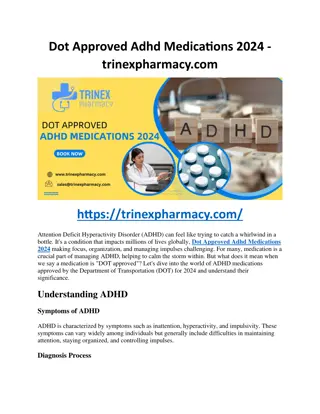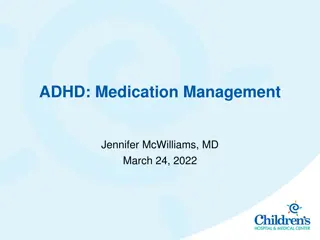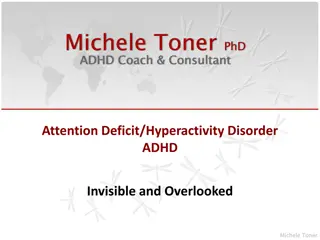Understanding Attention Deficit Hyperactivity Disorder (ADHD) in Children
A condition known as Attention Deficit Hyperactivity Disorder (ADHD) makes it challenging for children to focus and control their behavior. ADHD usually emerges before age seven and is characterized by symptoms of inattention, hyperactivity, and impulsivity. Children with ADHD may struggle to maintain focus on tasks, exhibit restless behavior, act without considering consequences, and have difficulty organizing activities. Recognizing the symptoms of inattention, hyperactivity, and impulsivity is crucial for identifying ADHD in children and seeking appropriate support and intervention.
Download Presentation

Please find below an Image/Link to download the presentation.
The content on the website is provided AS IS for your information and personal use only. It may not be sold, licensed, or shared on other websites without obtaining consent from the author. Download presentation by click this link. If you encounter any issues during the download, it is possible that the publisher has removed the file from their server.
E N D
Presentation Transcript
ATTENTION DEFICIT HYPERACTIVITY DISORDER
a condition that makes it difficult for children to pay attention and/or control their behavior Onset is before age seven The main symptoms are - inattention - hyperactivity - impulsivity . apparent when children are in preschool or when they are in their early school years. An estimated 3-5% of children have ADHD
What does inattention look like? difficulty keeping the mind on a task, or gets bored of a task easily. jumps from one task to another without completing the first task. easily distracted or doesn t follow instructions carefully. forgets and loses things that they need to complete a task.
What does hyperactivity look like? can t seem to sit still and constantly moving, roaming, touching things, squirming or fidgeting. What does impulsivity look like? speaks or acts without thinking about the consequences of that act. blurts out inappropriate comments, difficult to wait for their turn, and display emotions without restraint.
Symptoms of Inattention Fails to give close attention to details, makes careless mistakes Has difficulty sustaining attention Does not seem to listen Does not follow through or finish tasks
Symptoms of Inattention Has difficulty organizing tasks and activities Avoids or dislikes tasks requiring sustained effort Loses things needed for tasks Is easily distracted by extraneous stimuli Is often forgetful in daily activities
Symptoms of Hyperactivity Fidgets with hands or feet, squirms in seat Leaves seat in classroom or in other situations Runs about or climbs excessively Has difficulty playing or engaging in leisure activities quietly Talks excessively Acts as if driven by motor and cannot sit still
Symptoms of Impulsivity Blurts out answers before questions are completed Has difficulty waiting in line or awaiting turn in games or activities Interrupts or intrudes on others
ADHD: Getting a diagnosis Many normal children have some of these symptoms (especially young children!). the symptoms could be caused by another disorder entirely About 20-30% of children with ADHD also have a specific learning disability.
Tourette Syndrome: some children with ADHD also have this neurological disorder, symptoms of which include nervous tics and repetitive mannerisms. Bipolar Disorder: Differentiating between ADHD and BD in childhood can be difficult,
Oppositional Defiant Disorder: 1/3 to 1/2 of ADHD children also have ODD - rebellious, non- compliant, aggressive, and stubborn. Conduct Disorder: 20-40% of ADHD children develop CD aggressive, destructive, and at risk of getting into trouble at school or with the police. Anxiety & Depression: If co-occurring anxiety or depression is treated, children will be better able to handle the problems that accompany ADHD.
What causes ADHD? The cause of ADHD remains unknown neurobiology (some parts of the brain are smaller in children with ADHD) or genetics (ADHD tends to run in families, so there are likely genetic influences).
Although environmental and social factors (like child-rearing style) can influence the severity of the disorder, they do not cause the disorder. There is a relationship between alcohol and tobacco use during pregnancy and the risk for ADHD in the baby
TREATMENT FOR ADHD Medications have been used to treat ADHD for decades. Stimulants seem to be the most effective class of medication a combination treatment of medication and behavioral treatment are superior psychotherapy, behavioral therapy, social skills training, support groups, parenting skills training























